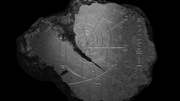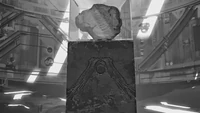
The Guidestone
The Guidestone was an ancient artifact created by members of the long-lost Hiigaran civilization. Smuggled aboard the Khar-Toba, it lay hidden in the sands of Kharak for almost three thousand years until it was discovered by the Kushan, descendents of the Exiled Hiigarans. The stone contained information permitting the Kushan to mount the Exodus to return to their forgotten and beloved homeworld of Hiigara.
Description[]

The Guidestone on its' pedestal.
The Guidestone was comprised mostly of vacuum-cooled sedimentary rock material, later determined to be approximately 3,000 years old in the Kharakian calendar. The stone was formed in layers, containing high-energy isotopes created only through the bombardment of extremely high-energy photons. Though nearly destroyed by the intense heat of the Khar-Toba crash, destroying the majority of the original artifact, what remained was an ornate depiction of the Galaxy etched on the flattest face of the stone. A line was detailed on the galactic depiction, tracing the direct route taken by the Exiles from their original home somewhere in the core to their exile on Kharak. The drawing also identified the core location as "Hiigara", a word common in all dialects that means "home." Hidden in the image were strings of numbers, giving a three-dimensional vector route that identified the path to Hiigara. This enabled the exiles to begin their return venture to their former homeworld.
History[]
The Guidestone was carved from a piece of rock from the surface of the Angel Moon in 6510 GSY, sometime after the battle of Sajuuk's Wrath and the Great Bentusi Harbor Ship, Bentus. The Hiigaran people had been found guilty of war crimes against the Bentusi, the Taiidani, and the Galactic Council as a whole. Their punishment was to be denied their hyperspace core and sent into exile. A cut of stone was taken from the moon, and onto it was carved the location of the Hiigaran homeworld, so that the exiles would never forget their home.
The stone was brought on board the Khar-Toba, one of the many prison transports set to take the exiles from their home to a world on the edge of the galaxy. When the few surviving transports arrived at the desert planet of Kharak, the Khar-Toba crashed in the High Desert, forming the site of the city of the same name. The survivors sealed the Guidestone in a special temple-observatory within the remains of the massive ship. Eventually, the survivors abandoned the city of Khar-Toba, migrating to the more temperate Northern Polar Region. The Kushan people fragmented into family-oriented clans called kiithid and fought with one another for many centuries.
The stone lay, undisturbed, within the ancient city ruins. It was rediscovered in 9429 GSY (1135 KDS) by a lone archaeologist, Mevath Sagald. Archaeologist Sagald returned the artifact to the central city of Tiir. There, every kiith leader examined the stone, verifying it to be an artifact not of that world. This finally answered the greatest question, the exogenesis question: were the Kushan, in fact, native to Kharak. With the exception of a few radical, religious kiithid who denied the truth of the Guidestone, the majority of the Kushan people were united for the first time in 250 years.
Sixty years later, the Guidestone was taken aboard the great Kushan Mothership that would take the Kushan on an Exodus back to their homeworld, Hiigara. The stone accompanied the exiles on their long trek back, residing on the Mothership during the whole of the Homeworld War, the data on its surface telling them which way to go and what lay ahead.
When the Kushan retook their homeworld, the Guidestone was relocated to the new capital city of Assaam Kiith'sid. There it remained, enshrined, for all Hiigarans to see.
Behind the Scenes[]
In a Sierra Magazine previewing the "coming" Homeworld game, the preview text describes the Guidestone as a crystal artifact which "transmitted a radio beacon with coordinates to your home", rather than simply describing the location pictorially as was on the final product.
